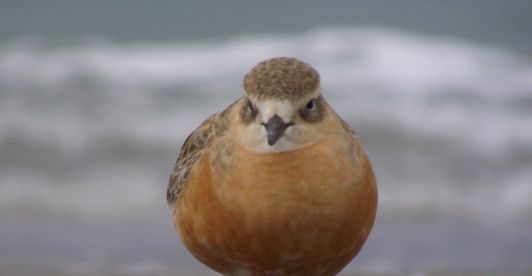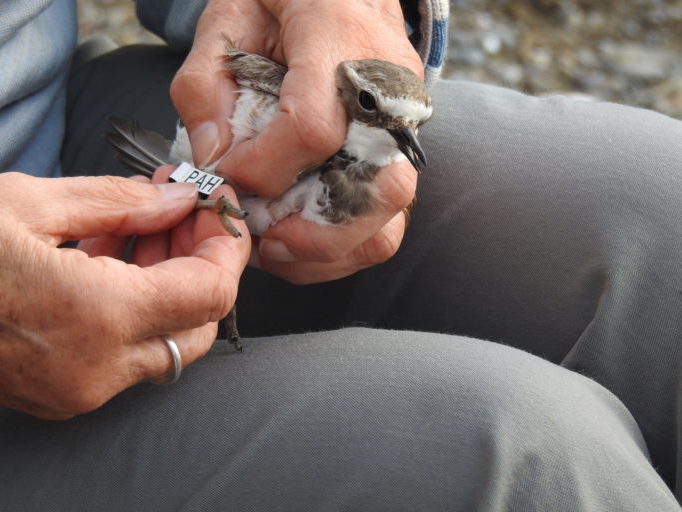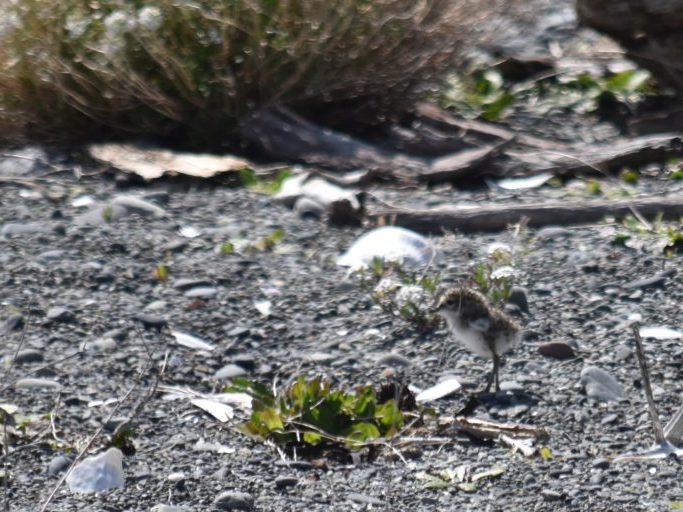For the last 20 years or so, an area of gravel has been slowly forming at Robinson Bay on the Eastbourne foreshore, just across the harbour from Wellington City. Then about 9 years ago banded dotterels (pohowera/tūturiwhatu) arrived and began trying to breed on the beach, right in front of Eastbourne’s houses.

The shingle expanse was just the sort of breeding area to appeal to dotterels. But nesting in such an urban area comes with some big challenges for a small, ground-nesting bird.
“Banded dotterels are classified as Nationally Vulnerable. It’s the same classification status as great spotted kiwi and whio,” points out Parker Jones, of East Harbour volunteer group MIRO (Mainland Island Restoration Operation), formed 15 years ago to trap possums in the hills behind Eastbourne and protect the local rata.
Unlike kiwi and whio, however, there’s no funding left in the pot to help protect this plucky little plover and they’re very vulnerable to predation.

“Banded dotterels nest out in the open shingle because traditionally their main enemy was the black-backed gull and in the open they could see danger coming,” Parker explains.
Eggs and chicks are well camouflaged from aerial predators. But these days hedgehogs and cats sniff out both and careless humans can easily trample the well-camouflaged nests. A lot of people like to walk on Eastbourne’s beachfront as well, putting breeding success of the new colony at risk.
With an active group of conservation volunteers already working on other East Harbour Regional Park projects, MIRO decided to do what it could to help the banded dotterels on the beach as well.
“When we started monitoring we found there were 3 reasons nests failed: predation by hedgehogs, southerly swells washing away nests at the lakes and people walking and riding quad bikes,” says Parker.
“We individually fenced each nest,” Parker says, “But people would walk right up to the fence to look at the nests, so now we fence the whole area with signage to explain why. Then last year we had a domestic cat issue, so used social media to ask Eastbourne cat owners to please keep their pets inside at night.”
A more established population of banded dotterels nests at Parangarahu Lakes, further south around the coastline from Eastbourne, just past the Pencarrow lighthouse. But that population also struggles to breed successfully.
The Wellington southerlies MIRO couldn’t do much about, but at least they could try and reduce the predators and human damage. Initially MIRO tried fencing the nests for added protection from human damage.
MIRO volunteers have been actively trapping predators and carrying out weekly monitoring of those nests too. Being a less populated area also means they have a few more options for defending this group of birds. MIRO uses a handheld application developed by GIS in Conservation to monitor the nest success. [This app can be used by anyone monitoring birds nests for no charge.]
“Taranaki Whānui Iwi, DOC, Hutt City Council and Greater Wellington Regional Council are all involved,” says Parker. “As soon as the dotterels arrive at Parangarahu Lakes, Iwi put a Rāhui on the nesting area to protect the birds. You can’t put a Rāhui on Eastbourne,” he adds. “We can also trap everything at the Lakes, including cats.”
Fencing is also erected at Parangarahu Lakes.
“Temporary fencing is erected with waratahs and strong wire that can’t be easily cut,” says Parker, “There’s signage explaining that it’s a nesting area and the whole area is trapped with A24 resetting traps, DOC 200s and Timms possum traps. It’s much more intensively trapped than best practice. It’s one of the most intensively trapped rural areas in New Zealand!”

MIRO volunteers trap outside the nesting area in the wider 350 hectares area of Parangarahu Lakes Block, part of East Harbour Regional Park. The area inside the fence is trapped by Darren Lees, who works for Greater Wellington Regional Council during the week and works voluntarily during weekends to help the dotterels. Darren has a love for birds and also acts as an advisor to the MIRO group, sharing his expertise.
“We’ve saved $4000 in funding costs by having MIRO volunteers trapping,” says Parker. “That’s funding has been used for other things such as information signage at the lakes.”
The volunteer work is making a significant difference to the nesting success of the birds.
“By extensively trapping and stopping people from disturbing the nests, nesting success has gone up from 3% to 30-40%,” says Parker.
It could make all the difference to the longterm survival of the colony – but extensive monitoring still needs to be done before the dotterel defenders will know if it’s enough.
“Niki McArthur (BirdsNZ and Wildlife Management International Ltd) is writing up a management masterplan,” says Parker. “He’s walked from Otaki to Castle Point identifying where banded dotterel nests are. Other groups will be able to use the methodology we’ve now tested to help their dotterel populations.”
The help can’t come a moment too soon.
“Banded dotterel surveys carried out on 33 Canterbury riverbeds showed that banded dotterels are declining on Canterbury rivers by almost 4% each year,” says Parker. “That means that every 20 years, banded dotterel numbers halve on Canterbury rivers. At that rate, it won’t be long before the threat status of banded dotterels is upgraded to ‘Nationally Endangered’.”
Such an assessment would mean that banded dotterels are classed as even more endangered than great spotted kiwi and whio. They’ve been overlooked for too long already. It’s time we took a bit more notice of that little banded bird roaming our southern riverbeds and nesting on Eastbourne’s foreshore.

